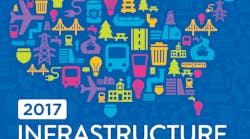When the American Society of Civil Engineers released its Infrastructure Report Card in 2021, the energy sector was rated at a ‘C–‘. That didn’t seem acceptable to me at the time: The infrastructure that our nation relies on for the basis of civilization was below average, or barely passing? We had just come out of the worst of the Covid pandemic, when American workers worked from home, and most children did virtual or hybrid school.
Reliable electricity and a robust internet connection were even more essential; work and schoolwork relied on it. My kids were high-school aged at the time, and a C– on one of their report cards wouldn’t have made me very happy either.
But I found out it can be worse. My kids got into college, and my daughter had a difficult class that we would have celebrated a C in. (She ended up changing majors.) So I guess you could say “it’s all relative?”
As far as our energy infrastructure, it “came home” with a worse grade this year than in 2021: a D+.
A “D,” as defined by ASCE, generally means "poor, at risk." It means "infrastructure is in fair to poor condition and mostly below standard, with many elements approaching the end of their service life. A large portion of the system exhibits significant deterioration. Condition and capacity are of serious concern with strong risk of failure.”
The energy sector really hasn’t budged much in ASCE’s eyes over the past 12 years. In the 2013 and 2017 Report Cards, Energy received a D+. We all know a lot has changed in energy over the past 12 years, and a D+ is more warranted this year than ever.
We are facing critical challenges, including supply chain issues, aging infrastructure, extreme weather, and lack of transmission capacity. These issues are being compounded by a growing reliance on energy-intensive technologies like electric vehicles, AI, and data centers, which are expected to more than double electricity demand by 2030.
While federal investments have ramped up to address these needs—particularly through the Infrastructure Investment and Jobs Act (IIJA)—ASCE noted that the efforts, while impactful, are not enough. Transmission investments have grown, and major projects like the Southline Transmission Project and the Cross-Tie Transmission Line are underway. In total, the IIJA allocates $73 billion to grid modernization, including $10.5 billion for resilience through the Grid Resilience and Innovation Partnerships Program. These funds are meant to bolster the grid against extreme weather and support the integration of renewable energy through more resilient and efficient infrastructure.
Despite these efforts, ASCE warns of a looming funding shortfall, estimating a $578 billion investment gap by 2033—even if current funding levels continue. Without continued support from policies like the IIJA and the Inflation Reduction Act, that gap could widen to $702 billion.
Interestingly, ASCE has been making some of the same recommendations to improve the grade over the last 12 years as well. Seems we can’t see to listen enough.
The ASCE’s recommendations in 2025 build on those from 2021 but reflect the mounting urgency and complexity of today’s energy landscape:
- Federal Energy Policy: Both 2021 and 2025 call for the adoption of a comprehensive federal energy policy to address current and future needs, including carbon reduction, renewables, and affordability. The language remains nearly identical.
- Consensus-Based Standards: Both years emphasize requiring consensus-based safety and reliability standards for overhead T&D lines, substations, and structures—an acknowledgment of the aging infrastructure and need for uniformity.
- Grid Reliability and Hardening: The 2021 and 2025 reports both focus on enhancing grid reliability through more frequent and effective asset inspections and call for a national hardening plan to prepare for disasters, including natural and man-made events.
- Infrastructure Design & Transmission Buildout: The need to consider life-cycle cost analysis and build additional transmission to deliver power efficiently from generation to high-demand areas is a consistent recommendation across both years.
Most of these topics have been talked about for longer than a decade. The nature of American politics (or any politics) has policy priorities shifting every four years. In a conversation I had with Larry Gasteiger, executive director of WIRES last week for a T&D World Live podcast session, we both agreed that some goals are “non-partisan,” such as reliability and resiliency.
Some industry leaders think that the grade is a bit unfair; ASCE is probably as tough as my some of my journalism professors were. But the electric utility industry itself is continuing to move forward, and I believe many regulators are willing to listen and learn. This is also a “technical” sector, and policy shouldn’t be created and passed without a good comprehension of the engineering, operational, and economic realities that utilities face every day.
About the Author
Nikki Chandler
Group Editorial Director, Energy
Nikki is Group Editorial Director of the Endeavor Business Media Energy group that includes T&D World, EnergyTech and Microgrid Knowledge media brands. She has 29 years of experience as an award-winning business-to-business editor, with 24 years of it covering the electric utility industry. She started out as an editorial intern with T&D World while finishing her degree, then joined Mobile Radio Technology and RF Design magazines. She returned to T&D World as an online editor in 2002. She has contributed to several publications over the past 25 years, including Waste Age, Wireless Review, Power Electronics Technology, and Arkansas Times. She graduated Phi Beta Kappa with a B.S. in journalism from the University of Kansas.



